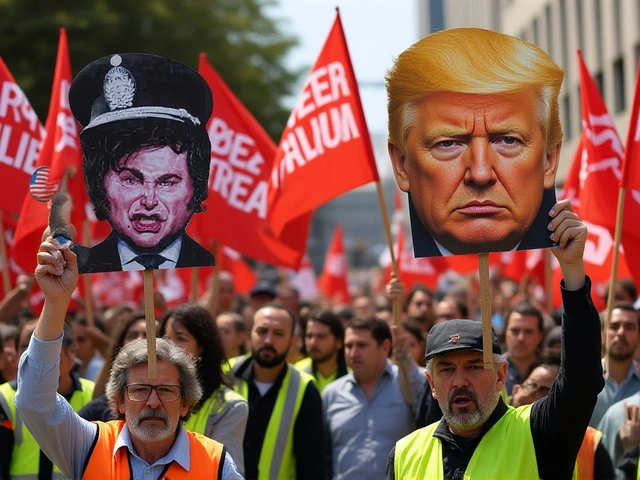A Nation Divided Between Mourning and Protest
Kenya stopped to remember on June 25, 2025, as the country juggled mourning and rising tension. President William Ruto landed in Dabaso, Kilifi County, for the burial of Mzee Gideon Baya Mung’aro—father of the county’s governor, Gideon Mung’aro. It wasn’t just any funeral; the guest list read like a cross-section of national leadership. Next to Ruto stood ODM’s Raila Odinga, Senate Speaker Amason Kingi, and Cabinet Secretary Hassan Joho, all reflecting the funeral’s political weight and symbolic timing.
On the very same day, memories of violence and loss from the 2024 protests resurfaced everywhere. Exactly a year before, streets across the nation had erupted in anger over the controversial Finance Bill. Those demonstrations left more than 60 people dead, fueling a storm of grief and outrage over how police responded. Now in 2025, young Kenyans—Gen Z in particular—weren’t willing to let that memory fade.
Nairobi, Mombasa, Kisii, and many more towns woke up to renewed marches. Protesters, mostly youth, chanted the names of victims and waved banners demanding justice and reforms. Social media buzzed with livestreams and footage, amplifying their message beyond city centers. The heavy police presence was impossible to miss—armored trucks parked at intersections, officers standing in clusters, and helicopters tracing the crowd’s path from above. The government wasn’t taking any chances, especially with the world watching this tense anniversary unfold.
Politics Amid Grief: Security, Reflection, and Mixed Signals
Ruto balanced his day with both mourning and state duties. Before heading to Kilifi, he met with Sultan Ali Allana, representing Prince Rahim Al Hussaini Aga Khan, at State House Nairobi. They talked up the work of the Aga Khan Development Network (AKDN) in Kenya’s health and education, with Ruto offering an official invitation to the Aga Khan himself. Plans include recognizing the Ismaili Imamat and awarding the Chief of the Order of the Golden Heart—moves aimed at bolstering Kenya’s ties with global partners, even as homegrown pressure mounts.
Back at the funeral, Ruto took the microphone to call for calm. "To every police officer, I give you my assurance that the Government of Kenya will support you and stand by you as you keep our families and property safe," he said. The words were carefully chosen. The president wants to reassure both the police, still smarting from past backlash, and a public demanding justice for last year’s deaths. He urged demonstrators to keep the peace, knowing that anger runs deep—especially among families who lost loved ones in the chaos of 2024.
Raila Odinga, forever a thorn in the government’s side and a voice for opposition, also had to strike a tricky balance. He warned protesters against violence but threw his weight behind the need for ongoing national soul-searching. His presence lent further gravity to the day's events in Kilifi, while across the nation, activists saw in him a potential ally—or, just as likely, a cautious elder wary of more bloodshed.
The context for all this was heightened security everywhere. Authorities remain wary; the events of last June still haunt the corridors of power. At every memorial, and across the protesting crowds, the names of the fallen echoed—a demand not just for safe streets, but for a reckoning with political accountability that looks far from finished.







Josh Tate
Can't even imagine the weight of standing there, grieving while the whole country watches.
Ruto's speech sounded like a tightrope walk between comfort and control.
The families lost so much, and the youth are still demanding answers.
It's a painful mix of respect for the dead and anger at the living.
John Smith
Honestly, the whole ceremony is just window dressing. The president’s promise to back the police is classic political spin, and it won't change the systemic issues that sparked last year’s protests. No amount of gold‑heart awards will silence a generation that’s already fed up.
Alex Soete
We’ve got a chance to turn this sorrow into real reform! If the gov keeps listening to the youths and actually pushes the finance bill changes they wanted, the nation could finally heal. Let’s keep the momentum going, not just at the funeral but in the streets and parliaments.
Cara McKinzie
so much drama, i cant even lol
Joseph Conlon
Look, while everyone is busy crying over a funeral, the real issue is that the state keeps treating protestors like scapegoats. It’s not about “window dressing” - it’s about a systematic pattern of ignoring constitutional rights. You can spin any speech, but if the police keep rolling in armored trucks and the courts stay silent, people will keep taking to the streets. The government should focus on real accountability instead of patting itself on the back for attending a burial. It's a classic case of style over substance, and that's why trust is eroding faster than any single ceremony could ever build.
Mohit Singh
Enough with the nonsense, the police need to be held accountable now!
Damian Liszkiewicz
Seeing the nation come together in grief while also demanding change is a profound reminder of our shared humanity 🙂.
We can honor the fallen by ensuring their cries translate into concrete policy reforms.
Let’s keep the conversation respectful and focused on solutions.
Angela Arribas
While the sentiment is noble, the grammar needs a tweak: "our shared humanity" should be followed by a comma, not a period, to maintain the flow.
Also, "their cries translate" would be clearer as "their cries are translated".
Sienna Ficken
Oh great, another political photo‑op, right? But in all seriousness, the youth’s persistence is like a fresh coat of paint on a cracked wall – it looks good until you realize the structure is still unsound.
Zac Death
It’s astonishing how a single day can encapsulate a nation’s contradictions.
On one hand, you have the president delivering a solemn tribute to a grieving family, invoking unity and reverence.
On the other, the same day witnesses armored trucks patrolling streets where young people chant for justice.
The police, once vilified for their heavy‑handed response in 2024, are now being publicly reassured of government support.
This paradox underscores the delicate balancing act the administration is performing.
Meanwhile, the opposition leader, Raila Odinga, walks a tightrope himself, warning against violence while subtly aligning with protestors’ demands.
The media’s livestreams capture raw emotions, turning the funeral into a de‑facto political stage.
Social platforms amplify every word, turning a regional ceremony into a global conversation.
Young Kenyans, especially Gen Z, are leveraging that visibility to press for reforms long overdue.
They cite not only the finance bill but also broader concerns about police accountability, transparency, and economic equity.
Each banner they wave carries the names of the 60+ victims from last year, a stark reminder that policy failures cost lives.
Government officials, perhaps unintentionally, use the funeral to showcase diplomatic ties, inviting foreign dignitaries and highlighting development projects.
Yet the underlying tension remains: can symbolic gestures ever substitute for substantive policy changes?
Historically, Kenya has seen cycles of protest, concession, and backsliding, suggesting that without sustained pressure, reforms may be superficial.
Ultimately, the day serves as both a mourning ritual and a catalyst, urging citizens to demand that grief turn into lasting institutional transformation.
Lizzie Fournier
Spot on, and thanks for laying it all out so clearly! The only thing I’d add is that local NGOs have already started drafting policy briefs – we should amplify their work.
JAN SAE
What a powerful moment!; The nation’s heart beats in rhythm with both sorrow and hope; Let’s remember, every voice counts; Unity is our strength!
Steve Dunkerley
From a governance perspective, the convergence of ceremonial protocol and civil dissent creates a high‑stakes stakeholder matrix. Aligning policy remediation with socio‑political capital will be essential to mitigate systemic risk.
Jasmine Hinds
Yo this is wild lets keep the energy up :)
Madison Neal
Understanding the collective trauma requires a nuanced approach that integrates psychosocial support with structural reforms.
John Crulz
Curious how the upcoming budget will address the public’s concerns – will there be tangible allocations for youth programs?
Anita Drake
It’s vital to recognize the diverse cultural narratives at play; honoring local traditions while fostering national dialogue can bridge divides.
Eduardo Lopez
Frankly, the spectacle of politicians swapping speeches at a funeral is nothing more than performative altruism; genuine change demands accountability, not applause.